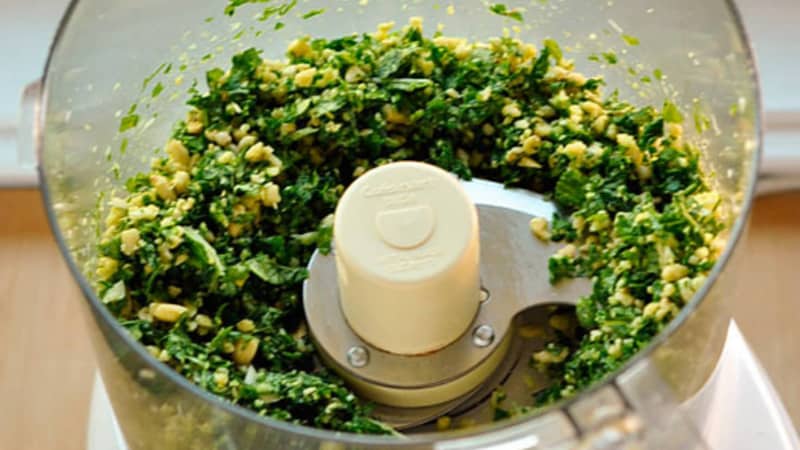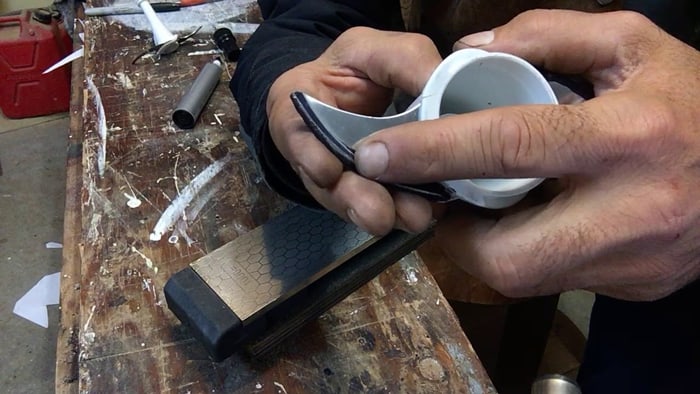Food processors made kitchen life easier. We use it for chopping, blending, grating, or shredding various vegetables, fruits, or hard cheese. But after using the blades several times, they’ll get blunt and may spoil the food. Although you can also replace the blades when there is an option of sharpening, you must go for it.
Among all the other tools, blades play an important role in daily kitchen life, whether it’s the knife or the ones from the food processor. Blades, too, have a shelf life. They get blunt after prolonged usage and lose the efficiency of their performance. But worry not, you can fix them!

How to Sharpen Food Processor’s Blades?
Before sharpening the blades, make sure to wear cut-resistant gloves to protect your hands from getting hurt. Use a screwdriver to unhook the blades from the food processor. Continue reading to know various ways to sharpen food processor’s blades for durability..

Using Electric Sharpener/ Electric Grinder
These sharpeners or grinders may weaken the blades because it strips away the metal. It tends to makes these blades harmful to use in the food processor.
Using Sharpening Stone
A sharpening stone or a file designed for the case is used to sharpen the blades manually. It is the best way to sharpen food processor blades for durability. You can easily buy a sharpening stone or file from the nearest shops or online market. Here are the steps by which you can easily sharpen the food processor’s blades with the help of a sharpening file or stone:

- Hold the blades with a firm grip in one hand.
- With the other hand, grasp the sharpening file or stone with a tight grip. Your fingers must be curling underneath the file, and your thumb should rest on the top.
- Avoid your fingers to slide over the metal while sharpening them.
- Start sliding the file or stone over the blade’s edge by moving it away from you. Keep firm but not hard pressure on the file while moving it over the blade.
- Repeat these 4 to 5 times.
- Now turn the blade over. Repeat the same process, but this time the sawing motion is in your direction.
- Test the sharpness of the blade by testing it over the paper. Cut the paper without applying pressure on it. If it cuts the paper smoothly, then it’s good to go.
- Rinse the blade and let it dry.
Using Rock Salt
Rock salt is famous for its beauty hacks as well as for health benefits. But have you heard that you can also use it for blade sharpening purposes? No? Here’s how you do that. The best thing about it is you don’t need to detach the blades from the food processor. Just follow these simple steps:

- Pick some solid pieces of rock salt and hook them with the blender machine.
- Please put them in the shell of the blender. Don’t use powdered salt, as it’s not resistive enough to sharpen the blades.
- Please turn on the machine and blend it well, but don’t blend it longer than 4 to 5 seconds.
- Repeat the process until the solid pieces turn into powder.
- After all the content is converted to powder, open the shell and check its blades.
- It’s sharpened well with just a small effort!
Using Ceramic Sharpener
The ceramic sharpener is a bit expensive, but its cheaper versions are also available. It is faster and lightweight, thus convenient to use. Here’s how to use it:
- Soak the ceramic sharpener before using it, as it works fine after soaking.
- Remove the plastic cover and place it on the position bench.
- Wear cut resistance gloves.
- Hold the handles with one hand firmly and spindles with the other hand.
- Gently slide the blades through the ceramic sharpener at least seven times.
- Test your blades by cutting a piece of paper without exerting any pressure.
- If the cut is sharp and smooth, then clean the blade thoroughly and use it.
Using Knife sharpener
A knife sharpener is available in affordable ranges. Apart from knives sharpening, it also sharpens your food processor’s blades. Knife sharpeners are easy to handle and light-weighted. To sharpen food processor’s blades, you need to follow these steps:

- Hold the spindle with one hand and a sharpener with the other. Let your fingers curl under the sharpener for a better grip.
- In a sawing motion, slide your blade slowly and continuously away from you. Repeat this process at least five times.
- Repeat the process by changing the sides of the blade.
- Test its sharpness by cutting a piece of paper.
- Clean the blade by rinsing it and making it ready to use.
Reasons Why Blades Get Blunt
Here are some points mentioned to highlight the mistakes we make while using food processors that can lead to the blunt blades:

Not Using the Pulse Button
We often forget about the pulse button, which is there for a reason. It gets the ingredients moving, present in the shell, and incorporates it evenly across the shell. It chops down all the ingredients before processing.
Using Food Processor in Place of The Blender
A food processor can do many things a blender can do, but it can’t do everything. For example, if you use a food processor to toss out the nut butter, it will make a mean pesto leaving the extra liquid. The food processor contains a fill line or a mark, and if the liquid exceeds this limit, there’s a risk of leaking out the sides or the top.

Adding Extra Large Ingredients
Sometimes to save time, we often throw big pieces of the onion or meat, making the blades blunt. So cut that onion, meat, or other ingredients into small sizes before throwing them in.
Conclusion
No matter what quality of food processor you are using, your food processor’s blades will get blunt after a certain time of usage. If you continue using that unsharp blades, you’ll be wasting a lot of food and time. From the processes mentioned above, you can easily sharpen the blades of your food processor.